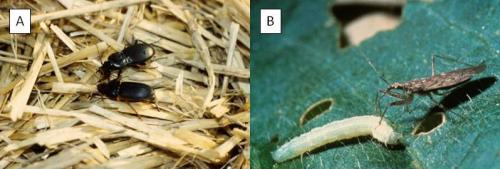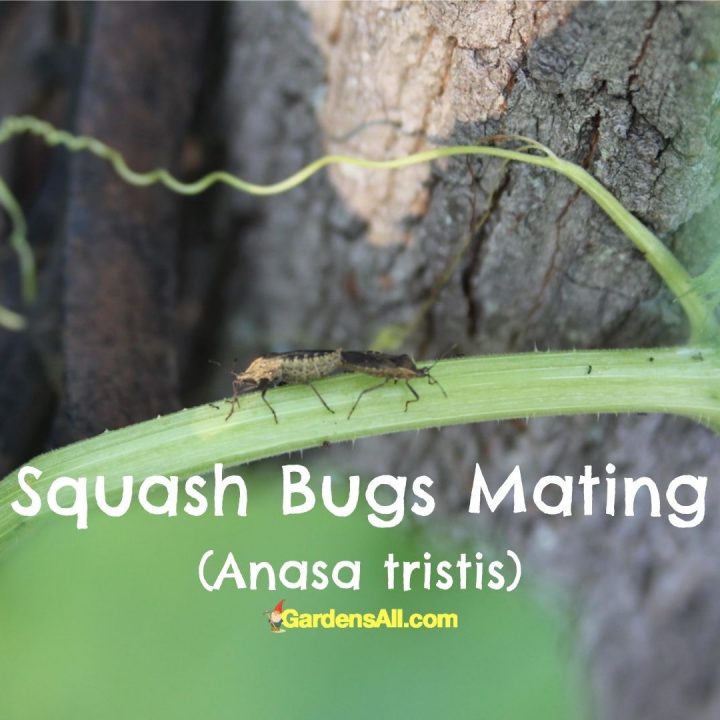Natural Methods for Avoiding Squash Bugs — Prevention is the Best Defense
If you’re growing any kind of squash or cucurbit, you’ll want to know how to prevent squash bugs, (Anasa Tristis), before they move in and attack your precious garden plants.
Prevention is possible, but for the best results you’ll want to employ as many preventive measures as possible.
What to Do if You Already Have Squash Bugs?
If your garden is already under attack by squash bugs, you may want to jump over to our article on how to get rid of squash bugs first.
Once you’ve gotten the defense arsenal employed, then you can come back here and fill in the extra pieces toward helping you avoid more issues.
Squash Bug Scientific Name
Anasa tristis (DeGeer) (Insecta: Hemiptera: Coreidae)
Here are some preliminary lines of defense that are simple and beneficial.

Prevent Squash Bugs From Ruining Your Squash Crops
1. Plant Squash Bug Resistant Squash Varieties
These varieties of squash are less likely to fall prey to squash bugs, especially if you’re growing the entrapment varieties they like most.
- Acorn, Royal acorn, Cucurbita pepo
- Butternut, Cucurbita moschata
- Cushaw, Cucurbita argyrosperma
- Royal Acorn, Cucurbita pepo
- Pink Banana, Cucurbita maxima
- Spaghetti squash, Cucurbita pepo
- Tetsukabuto, Cucurbita maxima
- Tromboncino squash, Cucurbita moschata
- Cheese squash, Cucurbita moschata
- Zucchini, Cucurbita pepo

2. Companion Planting to Deter Squash Bugs
Some plants are proven to have properties that tend to repel or deter some pests. However, in some cases it is simply the biodiverse plantings that help.[1]https://onlinelibrary.wiley.com/doi/abs/10.1046/j.0013-8703.2003.00102.x
The biodiversity of permaculture style of gardening is about creating a symbiotic ecosystem of plant and insect interaction that create a more balanced and harmonious environment. Toward that, one of the best defenses against squash bugs is companion plants that deter squash bugs in and around your squash plants.
A first line of prevention against squash bugs is to plant companion plants that squash bugs don’t like. For more on that, see our article on Companion Plants That Repel Squash Bugs.
Squash Companion Plants That May Deter Squash Bugs
- Bee balm
- Calendula
- Camelia
- Catnip
- Chives
- Dill
- Garlic
- Lemon balm
- Marigold
- Mint
- Nasturtium
- Petunia
- Radish
- Sunflower
- Tansy
- Tobacco
- Winter Savory
For more plants and details, please visit Companion Plants That Repel Squash Bugs.
3. Planting Trap Plants as Decoys
In conjunction with plants that deter squash bugs, some advise planting entrapment plants that attract squash bugs to a different area of the yard, near but not in your garden. These “decoy” plants will likely be a crop that you can expect to lose.
This is thought to create a double and compatible line of defense against squash bugs.
- Plant deterrent plants in and around your crops.
- Plant a lure squash crop that’s a squash bug free-for-all away from your garden.
Perimeter Trap Crop Theory
The theory is that by giving the squash bugs a free buffet of favorite foods on the perimeter of your garden, it will keep them away from your other plants. They’ll move away from your good crop surrounded by deterrent plants and instead occupy the lure crop.
You may be thinking by now, that you do not want to purposefully attract squash bugs! We get it. Opinions are mixed and more research is needed over time to know for sure.
However, the reality is, squash bugs are the number one problem plaguing squash crops, so even if you’ve never growth squash before, the probability of them finding your very first squash plant is high.
It may be better to do all that you can to protect one area and leave another area of plants “available” to them. You can still deploy methods for trying to get rid of squash bugs on the attacked plants. It may diminish the squash bug population, while giving your main plants the best chance at survival.
Hopefully, they’ll move away from your good crop surrounded by deterrent plants and instead occupy their favorite squash in the lure crop.
If you’ve tried this trap crop method we’d love to hear your observation on how well it worked or not.
Squash Bug Entrapment Plants – AKA – Trap Crops
- Pumpkins
- Blue Hubbard
- Yellow squash
Consider growing these “entrapment plants” for squash bugs in a perimeter area of your main garden. When coupled with deterrent plants, this has been found to help reduce squash infestation of main crops.
SOURCE: Univ. of Mass., Amherst
Companion planting includes deterrent plants that repel squash bugs and and entrapment plants on the perimeter that lure squash bugs to another area.
Will Late Planting of Trap Crops Reduce Squash Bugs for the Following Season?
The timing and management of the trap crop are key. Planting the trap crop late in the season can help to attract squash bugs away from the main crop, but only if the squash bugs are still active and laying eggs. Squash bugs typically overwinter in plant debris, so if the trap crop is destroyed before the bugs have a chance to lay eggs, it could potentially reduce the population for the next year.
However, the success of this method also depends on how well the trap crop is managed. If the trap crop is not destroyed or treated promptly after it has attracted the squash bugs, it could actually serve as a breeding ground for the pests and increase their population! 😳
4. Growing Vertically
Vertical gardening, such as using cattle panel archways may help reduce squash bugs by minimizing direct contact with the soil.
5. Clay Barrier Coating
We’ve successfully used Surround WP – a water soluble form of kaolin clay. When sprayed, it forms a protective white film around the plant that prevents egg laying and feeding. Surround WP also prevent heat stress and sun scald. It is OMRI listed for organic growers.
5. Squash Bug Predators
There aren’t many effective natural predators to squash bugs to studied to date. While the tachinid fly, Trichopoda pennipes, is often cited as a biological prevention, The University of Massachusetts Ag Extension service indicates otherwise.
That’s because the tachinid fly does not hatch in time to prevent squash bug damage to your crops.
However, the benefits of the tachinid reduction in squash bug population does accrue over time.
“Unfortunately, these [tachinid] fly eggs do not hatch and kill the squash bug in time to prevent reproduction and feeding by squash bugs.”
~Univ. of Mass., Amherst
Predators Bugs to Help Control Squash Bugs
- Damsel bugs – feed on young nymph squash bugs
- Ground beetles – field tests in Kentucky, showed ground beetles reduced squash bugs on yellow crookneck squash, with an increase in squash yields.
- Parasitoid wasps (in the families Encyrtidae and Scelionidae) attack squash bug eggs (Olson et al., 1996)[2]https://eorganic.org/node/5313
- Tachinid fly, Trichopoda pennipes – won’t really help in one season, but will accrue long term benefits
REFERENCE: eOrganic.com

Summary of Organic Squash Bug Prevention Methods
- CLEAR CROPS – Remove crops immediately after harvest; clean and till beds.
- CROP ROTATION – no cucurbits in the same beds as the previous season.
- TIDY GARDEN – Keep garden beds and areas cleared and free of debris.
- AVOID:
- mulch, especially wood chips and straw
- no-till gardening (although Ruth Stout would disagree)
- TRANSPLANTS – Use transplants rather than sowing from seeds.
- COVER PLANTS – Use frost covers in spring until flowers appear, to keep squash bugs at bay; then remove covers for pollination.
- MANUAL EXTERMINATION –
- Place boards or cardboard on beds around plants. Squash bugs will overnight under these shelters,and check each morning.
- Search underside of leaves daily, especially if you see yellow spots, wilting or ragged holes on leaves check underside and remove any eggs and squash bugs.
- GROW VERTICALLY – Trellis squash plants to minimize leaf cover at ground level for squash bugs to hide under.
- DETERRENT PLANTS – Plant deterrent companion plants throughout your garden.
- LURES – Plant trap crops – plants that lure squash bugs and check them often.
- CHICKENS – Keep chickens and guinea hens if you can. If you have the space and time to care for them, they will repay you with their eggs while happily searching your yard and garden for pests, including flea and tick control.
- FERTILIZE – Keeping plants well fed and fertilized will help them fight the good fight and fail if under attack. Here’s are some easy compost tea recipes.
- ORGANIC SPRAYS – Popular solutions include neem oil and diatomaceous earth – see more in how to get rid of squash bugs.
Popular Gardening Methods That May Contribute to Squash Bug Problems
We love the no-till and deep mulch gardening methods and use wood chip mulch liberally. We’re in the woods with a ready supply of materials for hugelkultur and no-till gardening methods, and have a free source for wood mulch year round.
However, those can gardening methods can all contribute to squash bug problems, and we’ve certainly had our share of those garden pests here, as well as problems with voles and moles.
RELATED ARTICLES: How to Get Rid of Squash Bugs, and Squash vine borer prevention and treatment.
What Do Squash Bugs Look Like?
Adult Squash Bug Picture

Squash Bug Laying Eggs

Squash Bug Eggs and Nymph Picture

How to Get Rid of Squash Bugs?
As indicated, prevention is always best, but if you end up with squash bugs, start here.
- Early detection is best; easier to get rid of squash bug eggs than adults
- Check plants daily and take action
- Pick eggs off plants
- Our preferred approach is to knock them into a container of soapy water[3]https://www.almanac.com/pest/squash-bugs
- Cut off leaves with eggs and destroy (burn of bag and trash them)
- Use tape, such as packing tape or duct tape and press the sticky side to the eggs and they lift right off
Daily diligence can keep squash bug issues under control and even eliminate them. But if you get them — and most gardens do — here’s more on how to get rid of squash bugs.
An ounce of prevention is worth many pounds of healthy squash!
~GardensAll.com

Wishing You Healthy Pest Free Plants!
I’m LeAura Alderson, a garden, herb and plant enthusiast with a passion for discovering the many edible and medicinal benefits of the plants all around us, including the weeds! I’m a writer, editor and media publisher for our family of websites.
While I was certified in fitness and life coaching, I am NOT a health practitioner. However, I’m a lifelong health enthusiast, with a keen interest in healthy, organic foods and making home remedies and the content we share is from our own experience and usage as well as that extracted from scientific research so that you can explore further on your own.
Always seek the advice and guidance of your health practitioners first and foremost.
As a family we’re steadily expanding our gardening, experimentation and knowledge around all things gardening, edible landscaping, fresh organic foods and self sustainability with farming in our future. I also own and manage iCreateDaily.com, a site all about transformation through creation, and the power of positivity, optimism and mindset.
References

